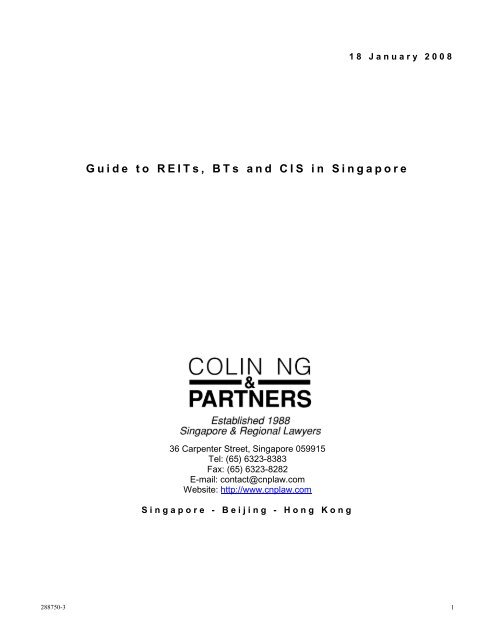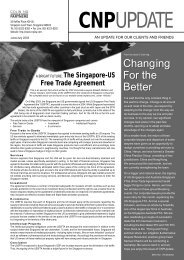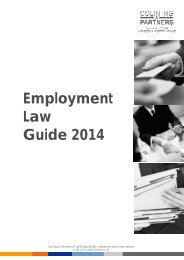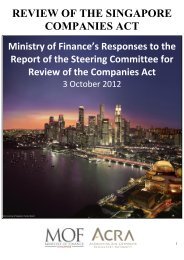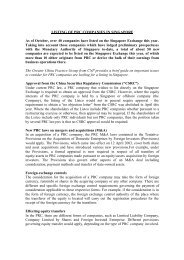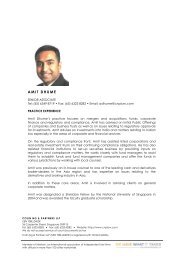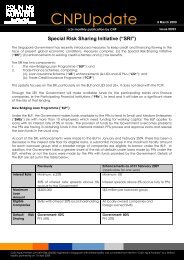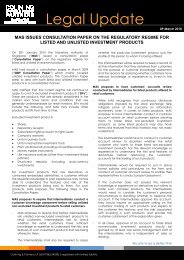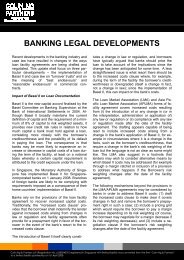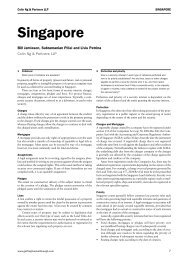Guide to REITs, BTs and CIS in Singapore - Colin Ng and Partners
Guide to REITs, BTs and CIS in Singapore - Colin Ng and Partners
Guide to REITs, BTs and CIS in Singapore - Colin Ng and Partners
Create successful ePaper yourself
Turn your PDF publications into a flip-book with our unique Google optimized e-Paper software.
1 8 J a n u a r y 2 0 0 8<br />
G u i d e t o R E I T s , B T s a n d C I S i n S i n g a p o r e<br />
36 Carpenter Street, S<strong>in</strong>gapore 059915<br />
Tel: (65) 6323-8383<br />
Fax: (65) 6323-8282<br />
E-mail: contact@cnplaw.com<br />
Website: http://www.cnplaw.com<br />
S i n g a p o r e - B e i j i n g - H o n g K o n g<br />
288750-3 1
C o l i n N g & P a r t n e r s<br />
G u i d e t o R E I T s , B T s a n d C I S i n S i n g a p o r e<br />
C o n t e n t s<br />
Contents<br />
Page<br />
Forward 3<br />
A. What is a REIT 4<br />
B. Should I do a REIT 6<br />
C. Do I qualify 8<br />
D. What must I do 11<br />
E. What is life after list<strong>in</strong>g a REIT 13<br />
F. What about bus<strong>in</strong>ess trusts 16<br />
G. What about collective <strong>in</strong>vestment schemes other than <strong>REITs</strong> 19<br />
H. CNP’s experience 23<br />
I. Glossary 24<br />
288750-3 2
C o l i n N g & P a r t n e r s<br />
G u i d e t o R E I T s , B T s a n d C I S i n S i n g a p o r e<br />
F o r w a r d<br />
Forward<br />
The lawyers at Col<strong>in</strong> <strong>Ng</strong> & <strong>Partners</strong> (“CNP”) have a wealth of experience <strong>in</strong> the areas of funds management <strong>and</strong><br />
real estate transactions. We have an established record <strong>in</strong> provid<strong>in</strong>g assistance <strong>to</strong> foreign <strong>and</strong> local clients <strong>and</strong> are<br />
proud <strong>to</strong> have been <strong>in</strong>volved <strong>in</strong> various aspects of advis<strong>in</strong>g <strong>and</strong>/or represent<strong>in</strong>g clients <strong>in</strong> property trust matters <strong>in</strong><br />
Australia, Ch<strong>in</strong>a, Hong Kong, India, Japan, Malaysia, <strong>and</strong> S<strong>in</strong>gapore, <strong>in</strong>clud<strong>in</strong>g advis<strong>in</strong>g <strong>in</strong> relation <strong>to</strong>, sett<strong>in</strong>g up<br />
<strong>and</strong> list<strong>in</strong>g a cross-border real estate <strong>in</strong>vestment trust (“REIT”) <strong>in</strong> S<strong>in</strong>gapore.<br />
This <strong>Guide</strong> provides <strong>in</strong>formation about three alternative legal structures for funds management, ie the BT, the <strong>CIS</strong><br />
<strong>and</strong> the REIT (a form of <strong>CIS</strong>). The <strong>Guide</strong> sets out the pros <strong>and</strong> cons of each structure <strong>and</strong> <strong>in</strong> relation <strong>to</strong> each<br />
provide <strong>in</strong>formation regard<strong>in</strong>g regula<strong>to</strong>ry requirements <strong>and</strong> <strong>in</strong> the case of listed <strong>REITs</strong>, <strong>in</strong>formation about SGX<br />
list<strong>in</strong>g requirements.<br />
The <strong>in</strong>formation conta<strong>in</strong>ed here is not a substitute for advice from your professional advisers. If you require specific<br />
advice on any aspect of funds management, our Corporate F<strong>in</strong>ance team will be pleased <strong>to</strong> assist you.<br />
288750-3 3
C o l i n N g & P a r t n e r s<br />
G u i d e t o R E I T s , B T s a n d C I S i n S i n g a p o r e<br />
W h a t i s a R E I T <br />
A. What is a REIT<br />
1. Introduction<br />
<strong>REITs</strong> were first <strong>in</strong>troduced <strong>in</strong> the USA <strong>in</strong> 1960 as a means for average <strong>in</strong>ves<strong>to</strong>rs <strong>to</strong> pool their capital for<br />
<strong>in</strong>vestment <strong>in</strong><strong>to</strong> large-scale <strong>in</strong>come produc<strong>in</strong>g commercial properties. In the past decade, the global REIT<br />
market has registered healthy growth, particularly <strong>in</strong> the USA <strong>and</strong> Australia. The success of the market <strong>in</strong><br />
these countries has motivated Asian <strong>and</strong> European jurisdictions <strong>to</strong> facilitate their own REIT markets<br />
through judicious regulation <strong>and</strong> tax <strong>in</strong>centives.<br />
2. Development<br />
The REIT market <strong>in</strong> S<strong>in</strong>gapore has developed quickly with<strong>in</strong> a short period. S<strong>in</strong>ce the launch of the first<br />
REIT <strong>in</strong> July 2002, the S<strong>in</strong>gapore REIT market has cont<strong>in</strong>ued <strong>to</strong> witness robust growth with the number <strong>and</strong><br />
market capitalisation of <strong>REITs</strong> more than doubl<strong>in</strong>g. As of 14 January 2008 there are 20 listed <strong>REITs</strong> with an<br />
aggregate market capitalisation of more than S$29.2 billion offer<strong>in</strong>g <strong>in</strong>ves<strong>to</strong>rs exposure <strong>to</strong> <strong>in</strong>come streams<br />
from residential properties, shopp<strong>in</strong>g malls, office build<strong>in</strong>gs, <strong>in</strong>dustrial properties <strong>and</strong> car parks.<br />
3. Parties <strong>in</strong>volved <strong>in</strong> sett<strong>in</strong>g up a REIT<br />
Typically, the parties <strong>in</strong>volved <strong>in</strong> a REIT are the sponsor, manager (responsible for <strong>in</strong>vestment strategies,<br />
recommend<strong>in</strong>g acquisitions <strong>and</strong> disposals of properties, account<strong>in</strong>g, compliance <strong>and</strong> <strong>in</strong>ves<strong>to</strong>r relations),<br />
trustee (responsible for look<strong>in</strong>g after the <strong>in</strong>terests of the unitholders <strong>and</strong> hold<strong>in</strong>g the REIT properties on<br />
trust), property managers (responsible for all ma<strong>in</strong>tenance, adm<strong>in</strong>istration, rentals <strong>and</strong> improvements of<br />
the real estate assets of the REIT), underwriters, issue managers, f<strong>in</strong>ancial advisers, legal advisers, tax<br />
<strong>and</strong> account<strong>in</strong>g consultants, valuers <strong>and</strong> other experts where required.<br />
4. How are listed <strong>REITs</strong> different from unit trusts<br />
Like unit trusts, <strong>REITs</strong> <strong>in</strong> S<strong>in</strong>gapore are managed by fund managers <strong>and</strong> trustees approved by MAS.<br />
Although <strong>REITs</strong> <strong>and</strong> conventional unit trusts <strong>in</strong>vest<strong>in</strong>g <strong>in</strong> securities are regulated under the same regime (ie<br />
the <strong>CIS</strong> regime), they differ <strong>in</strong> important respects.<br />
Unit trusts normally own a portfolio of securities, while <strong>REITs</strong> primarily own physical real estate assets <strong>and</strong><br />
real estate-related assets. Units <strong>in</strong> unlisted unit trusts can only be bought <strong>and</strong> sold through the fund<br />
managers of the unit trusts at their net asset value, ie prices usually quoted at the end of each trad<strong>in</strong>g day.<br />
By contrast, units <strong>in</strong> listed <strong>REITs</strong> can only be bought <strong>and</strong> sold on a s<strong>to</strong>ck exchange (<strong>in</strong> S<strong>in</strong>gapore, SGX)<br />
dur<strong>in</strong>g exchange trad<strong>in</strong>g hours at market prices.<br />
5. Structure<br />
A REIT is generally structured as a <strong>CIS</strong> <strong>and</strong> constituted either as a trust (unit trust) or a company. A REIT<br />
is a vehicle for <strong>in</strong>vestment <strong>in</strong> a portfolio of real estate assets, usually established with a view <strong>to</strong> generat<strong>in</strong>g<br />
<strong>in</strong>come for unitholders. <strong>REITs</strong> <strong>in</strong> S<strong>in</strong>gapore are constituted as unit trusts <strong>and</strong> are regulated under the <strong>CIS</strong><br />
regime. They can be listed or unlisted. <strong>REITs</strong> <strong>in</strong> S<strong>in</strong>gapore <strong>to</strong> date have been listed <strong>REITs</strong>. The units of<br />
listed <strong>REITs</strong> will be quoted for trad<strong>in</strong>g on SGX <strong>and</strong> bought <strong>and</strong> sold at market prices like any other listed<br />
securities.<br />
The majority of a REIT's assets <strong>in</strong> S<strong>in</strong>gapore must comprise real estate or real estate-related assets. These<br />
may <strong>in</strong>clude commercial, retail, <strong>in</strong>dustrial <strong>and</strong> residential properties that are located with<strong>in</strong> a specified<br />
country or region. Ownership of the real estate can be direct (held by the trustee of the REIT) or <strong>in</strong>direct<br />
(held via a special purpose vehicle of which the trustee is the shareholder).<br />
288750-3 4
C o l i n N g & P a r t n e r s<br />
G u i d e t o R E I T s , B T s a n d C I S i n S i n g a p o r e<br />
W h a t i s a R E I T <br />
The trust is governed by a trust deed. The trustee of the trust holds the legal title <strong>to</strong> the trust property <strong>and</strong><br />
the unitholders have the beneficial ownership of the trust property.<br />
6. Example of a typical REIT structure<br />
288750-3 5
C o l i n N g & P a r t n e r s<br />
G u i d e t o R E I T s , B T s a n d C I S i n S i n g a p o r e<br />
S h o u l d I d o a R E I T <br />
B. Should I do a REIT<br />
1. Advantages - <strong>REITs</strong> are popular for many reasons, <strong>in</strong>clud<strong>in</strong>g the follow<strong>in</strong>g:<br />
(a)<br />
Liquidity<br />
A real estate property is normally an illiquid asset. However, by trad<strong>in</strong>g units <strong>in</strong> listed <strong>REITs</strong> on a<br />
s<strong>to</strong>ck exchange, real estate <strong>in</strong>vestments become liquid assets unlike other traditional real estate<br />
<strong>in</strong>vestment vehicles <strong>and</strong> partnerships.<br />
(b)<br />
Tax transparency<br />
In S<strong>in</strong>gapore a tax rul<strong>in</strong>g will need <strong>to</strong> be obta<strong>in</strong>ed. Generally tax transparency will be granted on<br />
the taxable <strong>in</strong>come of a REIT that is distributed <strong>to</strong> unitholders such that the REIT will be taxed at<br />
the unitholder’s level <strong>and</strong> not at the REIT level (trust level). Once tax transparency is obta<strong>in</strong>ed,<br />
distributions <strong>to</strong> <strong>in</strong>dividuals (local or foreign) are tax exempt <strong>and</strong> non-<strong>in</strong>dividuals (mostly corporates)<br />
are taxed on the gross amount of distributions made out of taxable <strong>in</strong>come. Distributions <strong>to</strong> foreign<br />
non-<strong>in</strong>dividuals may be subject <strong>to</strong> S<strong>in</strong>gapore withhold<strong>in</strong>g tax.<br />
Distributions made out of capital ga<strong>in</strong>s are tax exempt <strong>in</strong> S<strong>in</strong>gapore (provided IRAS is will<strong>in</strong>g <strong>to</strong><br />
treat ga<strong>in</strong>s by a REIT as capital ga<strong>in</strong>s). A REIT can also obta<strong>in</strong> a stamp duty waiver.<br />
For cross border <strong>REITs</strong>, tax may be imposed <strong>in</strong> the foreign jurisdiction where the properties are<br />
located. A tax rul<strong>in</strong>g may exempt property-related <strong>in</strong>come from further tax <strong>in</strong> S<strong>in</strong>gapore.<br />
(c)<br />
Portfolio diversification <strong>and</strong> professional management<br />
<strong>REITs</strong> typically own multi-property portfolios with diversified tenant pools, thus reduc<strong>in</strong>g the risks of<br />
reliance on a s<strong>in</strong>gle property <strong>and</strong> tenant <strong>in</strong> the case of a directly owned real estate asset. <strong>REITs</strong><br />
allow <strong>in</strong>ves<strong>to</strong>rs the opportunity <strong>to</strong> buy <strong>in</strong><strong>to</strong> properties managed by professional property<br />
management companies.<br />
(d)<br />
Participation <strong>in</strong> the property market<br />
Most <strong>REITs</strong> are structured around large properties. With <strong>REITs</strong>, <strong>in</strong>ves<strong>to</strong>rs have the opportunity <strong>to</strong><br />
own stakes <strong>in</strong> properties that would otherwise be unavailable <strong>to</strong> them. Anyone from <strong>in</strong>stitutions <strong>to</strong><br />
members of the public can <strong>in</strong>vest <strong>in</strong> real estate through REITS.<br />
(e)<br />
Income distribution<br />
<strong>REITs</strong> normally have regular cash flows. In most cases, most of the revenues are derived from<br />
rental payments under contractually b<strong>in</strong>d<strong>in</strong>g lease agreements with specific tenure. Inves<strong>to</strong>rs<br />
should therefore study the occupancy rates of properties acquired by the REIT.<br />
(f)<br />
Distribution yield<br />
M<strong>and</strong>a<strong>to</strong>ry high distribution rules (90% – 100% <strong>in</strong> S<strong>in</strong>gapore) make <strong>REITs</strong> attractive <strong>to</strong> <strong>in</strong>ves<strong>to</strong>rs<br />
<strong>in</strong>terested <strong>in</strong> yield.<br />
(g)<br />
Performance moni<strong>to</strong>red<br />
Regula<strong>to</strong>rs, <strong>in</strong>dependent direc<strong>to</strong>rs, analysts, media <strong>and</strong> audi<strong>to</strong>rs moni<strong>to</strong>r REIT performance. The<br />
manager will often have a stake <strong>in</strong> the REIT <strong>to</strong> ensure alignment of <strong>in</strong>terests. Inves<strong>to</strong>rs ga<strong>in</strong><br />
protection through the regulation of s<strong>to</strong>ck markets <strong>and</strong> collective <strong>in</strong>vestment laws <strong>and</strong> regulations.<br />
288750-3 6
C o l i n N g & P a r t n e r s<br />
G u i d e t o R E I T s , B T s a n d C I S i n S i n g a p o r e<br />
S h o u l d I d o a R E I T <br />
(h)<br />
Low leverage<br />
There are m<strong>and</strong>a<strong>to</strong>ry debt ratio limits <strong>in</strong> most countries (<strong>in</strong> S<strong>in</strong>gapore, 35%).<br />
2. Disadvantages - Some of the risk fac<strong>to</strong>rs which affect returns on <strong>REITs</strong> are:<br />
(a)<br />
(b)<br />
(c)<br />
(d)<br />
(e)<br />
(f)<br />
(g)<br />
Rise/fall <strong>in</strong> rental <strong>in</strong>come <strong>and</strong> property prices result<strong>in</strong>g from a change <strong>in</strong> market conditions. As<br />
<strong>REITs</strong> are <strong>in</strong>tended <strong>to</strong> <strong>in</strong>vest primarily <strong>in</strong> real estate assets, a decl<strong>in</strong>e <strong>in</strong> the general level of real<br />
property prices could adversely affect the value of a REIT. The overall depth <strong>and</strong> liquidity of the<br />
real estate market <strong>and</strong> other assets <strong>in</strong> which <strong>REITs</strong> are <strong>in</strong>vested may fluctuate <strong>and</strong> this could<br />
correspond<strong>in</strong>gly affect the depth <strong>and</strong> liquidity of trad<strong>in</strong>g <strong>in</strong> <strong>REITs</strong>.<br />
The overall performance or expected performance of the real estate sec<strong>to</strong>r <strong>and</strong> other related<br />
sec<strong>to</strong>rs, or the general economic climate <strong>and</strong> outlook.<br />
Wear <strong>and</strong> tear or disasters which damage physical real estate assets owned by the REIT.<br />
Substantial <strong>in</strong>crease/fall <strong>in</strong> <strong>in</strong>terest rates, mak<strong>in</strong>g listed <strong>REITs</strong> less/more attractive as an <strong>in</strong>vestment<br />
<strong>in</strong>strument.<br />
Professionalism <strong>and</strong> experience affect<strong>in</strong>g the performance of the property management firm.<br />
Quality of assets owned by the <strong>REITs</strong>, affect<strong>in</strong>g susta<strong>in</strong>ability <strong>and</strong> stability of revenues.<br />
Laws <strong>and</strong> taxation changes affect<strong>in</strong>g real estate property prices which might impact on returns on<br />
<strong>REITs</strong>. <strong>REITs</strong> participat<strong>in</strong>g <strong>in</strong> properties or <strong>in</strong>vestments outside S<strong>in</strong>gapore may be subject <strong>to</strong> the<br />
risks of fluctuations <strong>in</strong> currency values, differences <strong>in</strong> generally accepted account<strong>in</strong>g pr<strong>in</strong>ciples, or<br />
local economic or political events <strong>in</strong> the countries <strong>in</strong> which those properties or <strong>in</strong>vestments are<br />
located.<br />
288750-3 7
C o l i n N g & P a r t n e r s<br />
G u i d e t o R E I T s , B T s a n d C I S i n S i n g a p o r e<br />
D o I q u a l i f y <br />
C. Do I qualify<br />
If I decide <strong>to</strong> set up a REIT, what do I need <strong>to</strong> do <strong>to</strong> qualify<br />
1. Regula<strong>to</strong>ry framework<br />
REITS <strong>in</strong> S<strong>in</strong>gapore are governed primarily by the SFA <strong>and</strong> its relevant regulations, by the <strong>CIS</strong> Code (<strong>in</strong><br />
particular its Property Funds <strong>Guide</strong>l<strong>in</strong>es) <strong>and</strong> by SGX list<strong>in</strong>g requirements.<br />
REITS that are <strong>to</strong> be offered <strong>to</strong> the retail market <strong>in</strong> S<strong>in</strong>gapore must be authorised by MAS if constituted <strong>in</strong><br />
S<strong>in</strong>gapore or recognised by MAS if constituted outside S<strong>in</strong>gapore. Before mak<strong>in</strong>g an application for list<strong>in</strong>g<br />
a REIT, it is important <strong>to</strong> ensure it is eligible for list<strong>in</strong>g on SGX.<br />
2. Approval by MAS<br />
The manager of a REIT is responsible for mak<strong>in</strong>g an application <strong>to</strong> MAS for approval of a REIT.<br />
(a)<br />
Authorisation<br />
MAS may authorise a REIT if it is satisfied:<br />
(i)<br />
(ii)<br />
(iii)<br />
(iv)<br />
the REIT is constituted <strong>in</strong> S<strong>in</strong>gapore;<br />
the REIT, its manager <strong>and</strong> the trustee have complied with the SFA <strong>and</strong> <strong>CIS</strong> Code<br />
requirements;<br />
the trustee of the REIT is a trustee approved by MAS;<br />
the manager of the REIT has met the follow<strong>in</strong>g SFA <strong>and</strong> <strong>CIS</strong> code requirements:<br />
• it is the holder of a capital markets services licence. A specialised licens<strong>in</strong>g regime<br />
for REIT managers will shortly be <strong>in</strong>troduced as a result of legislative changes;<br />
• it is a corporation with a physical office <strong>in</strong> S<strong>in</strong>gapore, <strong>and</strong> with m<strong>in</strong>imum<br />
shareholders funds of S$1 million;<br />
• it has a resident CEO;<br />
• it has at least 2 full time professional employees engaged <strong>in</strong> <strong>in</strong>vestment/asset<br />
management, f<strong>in</strong>anc<strong>in</strong>g, market<strong>in</strong>g <strong>and</strong> <strong>in</strong>ves<strong>to</strong>r relations activities;<br />
• the manager, as well as its CEO, direc<strong>to</strong>rs <strong>and</strong> professional employees meet the fit<br />
<strong>and</strong> proper criteria set out <strong>in</strong> the <strong>Guide</strong>l<strong>in</strong>es on Fit <strong>and</strong> Proper Criteria issued by<br />
MAS; <strong>and</strong><br />
• it has a m<strong>in</strong>imum 5 years track record <strong>in</strong> manag<strong>in</strong>g property funds or has<br />
appo<strong>in</strong>ted advisers or employed persons with at least 5 years experience <strong>in</strong><br />
<strong>in</strong>vest<strong>in</strong>g <strong>in</strong> <strong>and</strong>/or advis<strong>in</strong>g on real estate;<br />
(v)<br />
the manager <strong>and</strong> the trustee of the REIT have entered a trust deed constitut<strong>in</strong>g the REIT<br />
<strong>and</strong> conta<strong>in</strong><strong>in</strong>g prescribed covenants that comply with SFA <strong>and</strong> the <strong>CIS</strong> Code.<br />
288750-3 8
C o l i n N g & P a r t n e r s<br />
G u i d e t o R E I T s , B T s a n d C I S i n S i n g a p o r e<br />
D o I q u a l i f y <br />
(b)<br />
Recognition<br />
MAS may recognise a REIT if it is satisfied that:<br />
(i)<br />
(ii)<br />
(iii)<br />
(iv)<br />
the REIT is constituted outside S<strong>in</strong>gapore;<br />
the laws <strong>and</strong> practices of the foreign jurisdiction under which the REIT is constituted <strong>and</strong><br />
regulated afford <strong>to</strong> <strong>in</strong>ves<strong>to</strong>rs <strong>in</strong> S<strong>in</strong>gapore protection equivalent <strong>to</strong> that provided <strong>to</strong> them<br />
under S<strong>in</strong>gapore laws <strong>and</strong> regulations applicable <strong>to</strong> REITS;<br />
the REIT has appo<strong>in</strong>ted a S<strong>in</strong>gapore representative who is able <strong>to</strong> carry out certa<strong>in</strong><br />
statu<strong>to</strong>ry functions such as facilitat<strong>in</strong>g the issue <strong>and</strong> redemption of units, send<strong>in</strong>g reports<br />
<strong>and</strong> accept<strong>in</strong>g service of process. The representative may be an <strong>in</strong>dividual resident <strong>in</strong><br />
S<strong>in</strong>gapore or a S<strong>in</strong>gapore company or a foreign company registered under the Companies<br />
Act;<br />
the manager of the REIT:<br />
• is licensed or regulated <strong>in</strong> its home jurisdiction;<br />
• meets MAS fit <strong>and</strong> proper criteria; or<br />
• its related company manages at least S$500 million of discretionary funds <strong>in</strong><br />
S<strong>in</strong>gapore; <strong>and</strong><br />
(v)<br />
the REIT, its manager <strong>and</strong> the trustee where applicable have complied with the SFA <strong>and</strong><br />
<strong>CIS</strong> Code requirements.<br />
(c)<br />
Timeframe<br />
3. List<strong>in</strong>g requirements<br />
MAS may take at least 45 days <strong>to</strong> process an application for the authorisation or recognition of a<br />
REIT.<br />
REIT issuers seek<strong>in</strong>g admission <strong>to</strong> the Official List of SGX are required <strong>to</strong> comply with the follow<strong>in</strong>g<br />
requirements:<br />
(a)<br />
A REIT denom<strong>in</strong>ated <strong>in</strong> S<strong>in</strong>gapore dollars:<br />
(i)<br />
(ii)<br />
(iii)<br />
(iv)<br />
must have a m<strong>in</strong>imum asset size of at least S$20 million;<br />
must ensure that at least 25% of its units are <strong>to</strong> be held by 500 public unitholders;<br />
must limit its <strong>in</strong>vestments <strong>in</strong> companies related <strong>to</strong> its substantial unitholders’ <strong>in</strong>vestment<br />
managers or management companies <strong>to</strong> a maximum of 10% of gross assets; <strong>and</strong><br />
must restrict <strong>in</strong>vestments <strong>in</strong> unlisted securities <strong>to</strong> 30% of gross assets.<br />
(b)<br />
A REIT denom<strong>in</strong>ated <strong>in</strong> a foreign currency:<br />
(i)<br />
(ii)<br />
must have a m<strong>in</strong>imum asset size of US$20 million (or equivalent <strong>in</strong> other currencies);<br />
must have a spread of unitholders, necessary for an orderly market <strong>in</strong> the REIT; <strong>and</strong><br />
288750-3 9
C o l i n N g & P a r t n e r s<br />
G u i d e t o R E I T s , B T s a n d C I S i n S i n g a p o r e<br />
D o I q u a l i f y <br />
(iii)<br />
must have facilities for the transfer <strong>and</strong> registration of securities <strong>in</strong> S<strong>in</strong>gapore if it is<br />
established <strong>in</strong> a foreign country.<br />
(c)<br />
Other requirements<br />
Other list<strong>in</strong>g requirements <strong>in</strong>clude the follow<strong>in</strong>g:<br />
(i)<br />
(ii)<br />
(iii)<br />
<strong>in</strong>vestment objectives <strong>and</strong> policies for new REITS must not be changed <strong>in</strong> the first 3 years<br />
unless approved by special resolution of an extraord<strong>in</strong>ary general meet<strong>in</strong>g of the<br />
unitholders;<br />
the person responsible for manag<strong>in</strong>g the <strong>in</strong>vestments of the REIT must be reputable, have<br />
satisfac<strong>to</strong>ry experience <strong>in</strong> manag<strong>in</strong>g <strong>REITs</strong> <strong>and</strong> a track record of at least 5 years <strong>in</strong><br />
manag<strong>in</strong>g <strong>in</strong>vestments; <strong>and</strong><br />
the <strong>in</strong>vestment manager (if there is no management company), sponsor or trustee must be<br />
reputable <strong>and</strong> have an established track record <strong>in</strong> manag<strong>in</strong>g <strong>in</strong>vestments <strong>and</strong> have been<br />
operat<strong>in</strong>g for at least 5 years.<br />
288750-3 10
C o l i n N g & P a r t n e r s<br />
G u i d e t o R E I T s , B T s a n d C I S i n S i n g a p o r e<br />
W h a t m u s t I d o <br />
D. What must I do<br />
A REIT issuer has an important role <strong>and</strong> responsibility <strong>in</strong> the process of obta<strong>in</strong><strong>in</strong>g a list<strong>in</strong>g.<br />
1. Prospectus requirements<br />
A REIT issuer must ensure that the prospectus complies with SFA, <strong>CIS</strong> Code, SGX List<strong>in</strong>g Manual <strong>and</strong> the<br />
IOSCO Document requirements. It must conta<strong>in</strong> certa<strong>in</strong> <strong>in</strong>formation <strong>in</strong>clud<strong>in</strong>g any material <strong>in</strong>formation<br />
<strong>in</strong>ves<strong>to</strong>rs would reasonably require <strong>to</strong> make <strong>in</strong>vestment decisions, for example details of distribution policy<br />
<strong>and</strong> dates, borrow<strong>in</strong>g powers, capitalization, f<strong>in</strong>anc<strong>in</strong>g, <strong>in</strong>vestment objectives, policy, particulars <strong>and</strong> risks,<br />
use of REIT proceeds, ownership of units issued by the REIT, <strong>in</strong>terested party transactions, details of<br />
properties <strong>to</strong> be <strong>in</strong>jected <strong>in</strong><strong>to</strong> the REIT, pro forma balance sheets, profit projections, details of sponsor,<br />
manager <strong>and</strong> trustee, fees payable, material agreements <strong>and</strong> experts’ statements.<br />
2. List<strong>in</strong>g procedures<br />
The usual steps <strong>in</strong> the list<strong>in</strong>g process for a REIT are as follows:<br />
(a)<br />
The issuer submits a list<strong>in</strong>g application prepared <strong>in</strong> compliance with SGX List<strong>in</strong>g Manual<br />
requirements <strong>to</strong>gether with the support<strong>in</strong>g documents.<br />
(i)<br />
Documents <strong>to</strong> be submitted with the list<strong>in</strong>g application<br />
One copy of the follow<strong>in</strong>g documents must be submitted <strong>to</strong>gether with the prescribed list<strong>in</strong>g<br />
fee:<br />
• prospectus;<br />
• compliance checklist;<br />
• trust deed;<br />
• memor<strong>and</strong>um <strong>and</strong> articles of association, if applicable; <strong>and</strong><br />
• annual accounts for last 5 f<strong>in</strong>ancial years, if applicable.<br />
(ii)<br />
Timeframe<br />
SGX normally takes four weeks <strong>to</strong> decide on an application from the date of its submission.<br />
(b)<br />
SGX considers the application <strong>and</strong> may grant approval <strong>in</strong>-pr<strong>in</strong>ciple (with or without conditions).<br />
Documents <strong>to</strong> be submitted after approval <strong>in</strong>-pr<strong>in</strong>ciple<br />
The follow<strong>in</strong>g documents should be submitted <strong>to</strong> SGX after the REIT receives approval <strong>in</strong>-pr<strong>in</strong>ciple:<br />
• the signed list<strong>in</strong>g undertak<strong>in</strong>g;<br />
• a specimen of the certificate <strong>to</strong> be issued; <strong>and</strong><br />
• 120 copies of the prospectus.<br />
288750-3 11
C o l i n N g & P a r t n e r s<br />
G u i d e t o R E I T s , B T s a n d C I S i n S i n g a p o r e<br />
W h a t m u s t I d o <br />
(c)<br />
(d)<br />
(e)<br />
(f)<br />
The f<strong>in</strong>al copy of the prospectus must be lodged with MAS <strong>and</strong> SGX. Registration of the document<br />
with MAS will take place between 14 <strong>and</strong> 21 days of lodgment unless extended by MAS <strong>to</strong> 28 days.<br />
On satisfaction of all conditions, the REIT is admitted <strong>to</strong> the Official List.<br />
The REIT may <strong>in</strong>vite subscription for its units.<br />
The REIT may allot <strong>and</strong> issue units.<br />
288750-3 12
C o l i n N g & P a r t n e r s<br />
G u i d e t o R E I T s , B T s a n d C I S i n S i n g a p o r e<br />
W h a t i s l i f e a f t e r l i s t i n g a R E I T <br />
E. What is life after list<strong>in</strong>g a REIT<br />
1. Who is responsible<br />
For a listed REIT different people or entities <strong>in</strong>clud<strong>in</strong>g the manager, direc<strong>to</strong>rs <strong>and</strong> substantial unitholders (ie<br />
unitholders hold<strong>in</strong>g more than 5% of the REIT’s units) have cont<strong>in</strong>u<strong>in</strong>g obligations after list<strong>in</strong>g.<br />
2. Manager’s obligations<br />
(a)<br />
The manager of a REIT is primarily responsible for compliance with post list<strong>in</strong>g obligations<br />
conta<strong>in</strong>ed <strong>in</strong> the follow<strong>in</strong>g statu<strong>to</strong>ry, regula<strong>to</strong>ry <strong>and</strong> other relevant documentation:<br />
(i)<br />
(ii)<br />
(iii)<br />
(iv)<br />
(v)<br />
(vi)<br />
(vii)<br />
the SGX List<strong>in</strong>g Manual;<br />
the SFA;<br />
the Securities <strong>and</strong> Futures (Offers of Investments) (Collective Investment Schemes)<br />
Regulations 2005;<br />
the <strong>CIS</strong> Code;<br />
the Code of Corporate Governance;<br />
the trust deed; <strong>and</strong><br />
the prospectus.<br />
(b)<br />
Some cont<strong>in</strong>u<strong>in</strong>g obligations are periodic <strong>and</strong> others are event specific.<br />
(i)<br />
Periodic obligations <strong>in</strong>clude:<br />
• f<strong>in</strong>ancial statement announcements on a quarterly <strong>and</strong> half yearly basis;<br />
• distributions <strong>to</strong> unitholders must be announced;<br />
• preparation of f<strong>in</strong>ancial reports <strong>and</strong> announcements of net asset value;<br />
• a full valuation of each of the REIT’s real estate assets <strong>to</strong> be conducted once a<br />
year by a valuer; <strong>and</strong><br />
• at f<strong>in</strong>ancial year end the issue of an annual report conta<strong>in</strong><strong>in</strong>g <strong>in</strong>formation required<br />
under the Property Funds <strong>Guide</strong>l<strong>in</strong>es of the <strong>CIS</strong> Code <strong>and</strong> under the SGX List<strong>in</strong>g<br />
Manual (for example, the chairman’s statement, audited accounts, details of all<br />
assets of the REIT <strong>and</strong> description of its corporate governance practices).<br />
(ii)<br />
Specific event obligations <strong>in</strong>clude:<br />
• announcements of any material <strong>in</strong>formation;<br />
• announcements of major transactions <strong>and</strong> <strong>in</strong>terested party transactions <strong>and</strong><br />
(where certa<strong>in</strong> thresholds are breached) obta<strong>in</strong><strong>in</strong>g unitholders approval for these<br />
transactions;<br />
288750-3 13
C o l i n N g & P a r t n e r s<br />
G u i d e t o R E I T s , B T s a n d C I S i n S i n g a p o r e<br />
W h a t i s l i f e a f t e r l i s t i n g a R E I T <br />
• immediate announcement of certa<strong>in</strong> matters <strong>in</strong>clud<strong>in</strong>g mergers or acquisitions,<br />
purchase or sale of a significant asset of the REIT, change <strong>in</strong> control of the<br />
manager <strong>and</strong> appo<strong>in</strong>tment or resignation of direc<strong>to</strong>rs, CEO, general manager or<br />
other executive officers of equivalent rank, company secretary <strong>and</strong> audi<strong>to</strong>rs of the<br />
manager; <strong>and</strong><br />
• obta<strong>in</strong><strong>in</strong>g the trustee’s confirmation, where required, that an <strong>in</strong>terested party<br />
transaction is carried out on normal commercial terms.<br />
(iii)<br />
Other obligations<br />
3. Direc<strong>to</strong>rs’ obligations<br />
The manager is required:<br />
• <strong>to</strong> manage a REIT for the benefit of its unitholders;<br />
• <strong>to</strong> announce <strong>to</strong> SGX the particulars of its unithold<strong>in</strong>gs <strong>and</strong> any changes <strong>to</strong> such<br />
hold<strong>in</strong>gs with<strong>in</strong> 2 bus<strong>in</strong>ess days after it acquires or disposes of any such units;<br />
• <strong>to</strong> implement procedures <strong>to</strong> m<strong>in</strong>imise potential conflict of <strong>in</strong>terests situations; <strong>and</strong><br />
• not <strong>to</strong> manage any other REIT.<br />
The direc<strong>to</strong>rs have certa<strong>in</strong> obligations <strong>in</strong> relation <strong>to</strong> their personal deal<strong>in</strong>gs. For example, the direc<strong>to</strong>rs are<br />
required <strong>to</strong> notify the manager, trustee <strong>and</strong> SGX with<strong>in</strong> 2 bus<strong>in</strong>ess days of their acquisition of units or of<br />
any <strong>in</strong>terests <strong>in</strong> the units of a REIT <strong>and</strong>/or any change <strong>to</strong> their <strong>in</strong>terests.<br />
4. Substantial unitholders’ obligations<br />
(a)<br />
Substantial unitholders are required <strong>to</strong> notify the manager, trustee <strong>and</strong> SGX:<br />
• their deemed <strong>and</strong> direct hold<strong>in</strong>gs of the units <strong>in</strong> the REIT;<br />
• any subsequent change <strong>in</strong> the percentage level of such hold<strong>in</strong>gs; <strong>and</strong><br />
• when they cease <strong>to</strong> be a substantial unitholder (cease <strong>to</strong> hold 5% or more of the units <strong>in</strong><br />
the REIT),<br />
with<strong>in</strong> 2 bus<strong>in</strong>ess days of acquir<strong>in</strong>g such hold<strong>in</strong>gs or such changes or cessation.<br />
(b)<br />
The manager must make a separate announcement <strong>to</strong> SGX <strong>in</strong> connection with substantial<br />
unithold<strong>in</strong>gs upon receiv<strong>in</strong>g such notification.<br />
5. Investment criteria<br />
In S<strong>in</strong>gapore a REIT must <strong>in</strong>vest primarily <strong>in</strong> real estate <strong>and</strong> real estate-related assets. The <strong>in</strong>vestment<br />
policy of a REIT must be adhered <strong>to</strong> for the first three years unless an extraord<strong>in</strong>ary general meet<strong>in</strong>g of<br />
unitholders agrees <strong>to</strong> amendments by a special resolution.<br />
(a)<br />
Permissible <strong>in</strong>vestments<br />
The follow<strong>in</strong>g are permissible <strong>in</strong>vestments:<br />
288750-3 14
C o l i n N g & P a r t n e r s<br />
G u i d e t o R E I T s , B T s a n d C I S i n S i n g a p o r e<br />
W h a t i s l i f e a f t e r l i s t i n g a R E I T <br />
(i)<br />
(ii)<br />
(iii)<br />
(iv)<br />
(v)<br />
real estate;<br />
real estate-related assets;<br />
listed or unlisted debt securities <strong>and</strong> listed shares of or issued by a local or foreign nonproperty<br />
company;<br />
government securities; <strong>and</strong><br />
cash or cash equivalent items.<br />
(b)<br />
Investment restrictions<br />
A REIT’s restrictions <strong>in</strong> relation <strong>to</strong> its <strong>in</strong>vestments <strong>in</strong>clude the follow<strong>in</strong>g:<br />
(i)<br />
(ii)<br />
(iii)<br />
(iv)<br />
(v)<br />
(vi)<br />
(vii)<br />
at least 75% of a its deposited property should be <strong>in</strong>vested <strong>in</strong> <strong>in</strong>come-produc<strong>in</strong>g real estate;<br />
it must not undertake property development activities whether on its own, <strong>in</strong> jo<strong>in</strong>t venture or<br />
by <strong>in</strong>vest<strong>in</strong>g <strong>in</strong> unlisted property development companies, unless the REIT <strong>in</strong>tends <strong>to</strong> hold<br />
the developed property upon completion;<br />
it must not <strong>in</strong>vest <strong>in</strong> vacant l<strong>and</strong> <strong>and</strong> mortgages (except for mortgage-backed securities);<br />
its <strong>in</strong>vestments <strong>in</strong> uncompleted property developments (local <strong>and</strong> foreign) should not<br />
exceed 10% of its <strong>to</strong>tal assets;<br />
for <strong>in</strong>vestments <strong>in</strong> listed or unlisted debt securities <strong>and</strong> listed shares of or issued by local or<br />
foreign non-property companies, government securities <strong>and</strong> securities issued by supranational<br />
agencies or a S<strong>in</strong>gapore statu<strong>to</strong>ry board, <strong>and</strong> cash <strong>and</strong> equivalent items, not more<br />
than 5% of the REIT’s deposited property can be <strong>in</strong>vested <strong>in</strong> any one issuer’s securities or<br />
any one manager’s funds, but note this does not apply <strong>to</strong> deposits placed with eligible<br />
f<strong>in</strong>ancial <strong>in</strong>stitutions <strong>and</strong> <strong>in</strong>vestments <strong>in</strong> high-quality money market <strong>in</strong>struments or debt<br />
securities;<br />
not more than 10% of the REIT’s revenue should be derived from sources other than rental<br />
payments <strong>to</strong> be made by tenants <strong>and</strong> <strong>in</strong>terest, dividends <strong>and</strong> other similar payments from<br />
<strong>in</strong>vestments held by the REIT; <strong>and</strong><br />
borrow<strong>in</strong>gs <strong>and</strong> deferred payments (aggregate leverage) must not exceed 35% of the<br />
REIT’s deposited property, except if a credit rat<strong>in</strong>g has been obta<strong>in</strong>ed, <strong>in</strong> which case the<br />
aggregate leverage can be up <strong>to</strong> 60% of the deposited property.<br />
288750-3 15
C o l i n N g & P a r t n e r s<br />
G u i d e t o R E I T s , B T s a n d C I S i n S i n g a p o r e<br />
W h a t a b o u t b u s i n e s s t r u s t s <br />
F. What about bus<strong>in</strong>ess trusts<br />
1. New <strong>in</strong>vestment asset class<br />
The BT is a new <strong>in</strong>vestment asset class <strong>in</strong>troduced by MAS. The Bus<strong>in</strong>ess Trust Act (“BTA”) which came<br />
<strong>in</strong><strong>to</strong> effect <strong>in</strong> Oc<strong>to</strong>ber 2004 provides the framework for the governance of <strong>BTs</strong> <strong>and</strong> regulates the rights of<br />
unitholders <strong>and</strong> credi<strong>to</strong>rs <strong>and</strong> the duties <strong>and</strong> accountability of the trustee-manager <strong>and</strong> direc<strong>to</strong>rs of <strong>BTs</strong>.<br />
Pursuant <strong>to</strong> the BTA, the SFA was amended <strong>to</strong> regulate public offers of units <strong>in</strong> <strong>BTs</strong> <strong>in</strong> the same way as<br />
offers of shares <strong>in</strong> companies <strong>and</strong> offers of units <strong>in</strong> <strong>CIS</strong>. Inves<strong>to</strong>rs <strong>in</strong> <strong>BTs</strong> have similar statu<strong>to</strong>ry protections<br />
under the SFA as the subscribers <strong>to</strong> share offers or <strong>to</strong> offers of units <strong>in</strong> <strong>CIS</strong>.<br />
2. What are <strong>BTs</strong><br />
<strong>BTs</strong> are bus<strong>in</strong>ess enterprises structured as trusts. They are hybrid structures with elements of both<br />
companies <strong>and</strong> trusts. They are an alternative form of bus<strong>in</strong>ess structure <strong>to</strong> companies <strong>and</strong> are already <strong>in</strong><br />
use <strong>in</strong> Australia, Canada <strong>and</strong> USA.<br />
A BT is created by a trust deed under which the trustee-manager has legal ownership of the assets of the<br />
underly<strong>in</strong>g bus<strong>in</strong>ess <strong>and</strong> manages the bus<strong>in</strong>ess for the benefit of the beneficiaries of the trust. The ma<strong>in</strong><br />
difference between a BT <strong>and</strong> a unit trust regulated by the <strong>CIS</strong> Code is that a BT’s activities are more<br />
aligned <strong>to</strong> those of a company. Like a company, a BT operates <strong>and</strong> runs as a bus<strong>in</strong>ess enterprise.<br />
However, unlike a company, a BT is not a separate legal entity.<br />
MAS has sought <strong>to</strong> align the BT regime with that of companies as much as possible. For example:<br />
(a)<br />
(b)<br />
(c)<br />
(d)<br />
like companies, <strong>BTs</strong> have <strong>to</strong> comply with registration requirements;<br />
unitholders of a BT have limited liability as do shareholders of a company;<br />
taxation for a BT is similar <strong>to</strong> that for a company (s<strong>in</strong>gle-tier system); <strong>and</strong><br />
units of a BT can be listed on SGX <strong>and</strong> are subject <strong>to</strong> prospectus <strong>and</strong> disclosure requirements.<br />
3. Structure of a BT<br />
<strong>BTs</strong> <strong>in</strong> S<strong>in</strong>gapore are structured with a s<strong>in</strong>gle responsible entity, the trustee-manager, which is a company<br />
<strong>in</strong>corporated under the Companies Act <strong>and</strong> it is the manager as well as the trustee of the trust assets of the<br />
BT. The trustee-manager has legal ownership of the assets of the underly<strong>in</strong>g bus<strong>in</strong>ess <strong>and</strong> is responsible<br />
for safeguard<strong>in</strong>g the <strong>in</strong>terests of unitholders <strong>and</strong> manag<strong>in</strong>g the bus<strong>in</strong>ess of the BT. Inves<strong>to</strong>rs can <strong>in</strong>vest <strong>in</strong><br />
the underly<strong>in</strong>g bus<strong>in</strong>ess by subscrib<strong>in</strong>g for units <strong>in</strong> the BT <strong>in</strong> a similar way as they <strong>in</strong>vest <strong>in</strong> shares <strong>in</strong> a<br />
company. Unitholders are granted economic benefits <strong>in</strong> the form of dividends paid out by the BT.<br />
4. Advantages of <strong>BTs</strong><br />
The BT structure is an alternative form of bus<strong>in</strong>ess vehicle with favorable characteristics <strong>in</strong>clud<strong>in</strong>g:<br />
(a)<br />
(b)<br />
(c)<br />
limited liability of unitholders;<br />
dividends can be paid out of cash profits <strong>in</strong>stead of account<strong>in</strong>g profits; <strong>and</strong><br />
<strong>in</strong>vestment restrictions applicable <strong>to</strong> <strong>CIS</strong> (eg debt ratio limit of 35%) will not apply <strong>to</strong> <strong>BTs</strong>.<br />
288750-3 16
5. Types of bus<strong>in</strong>esses suitable for <strong>BTs</strong><br />
C o l i n N g & P a r t n e r s<br />
G u i d e t o R E I T s , B T s a n d C I S i n S i n g a p o r e<br />
W h a t a b o u t b u s i n e s s t r u s t s <br />
S<strong>in</strong>ce dividends <strong>to</strong> unitholders can be paid from cash profits, a BT structure is particularly suited <strong>to</strong><br />
bus<strong>in</strong>esses with high levels of capital <strong>in</strong>vestment <strong>and</strong> strong cash flows such as real estate <strong>in</strong>vestment<br />
funds, bus<strong>in</strong>esses <strong>in</strong> the utilities sec<strong>to</strong>r or <strong>in</strong>frastructure/asset-backed bus<strong>in</strong>esses.<br />
The fact that a BT can pay dividends from its operational cash flow could prove <strong>to</strong> be important for an<br />
<strong>in</strong>frastructure or asset-backed bus<strong>in</strong>ess, for <strong>in</strong>stance a <strong>to</strong>ll road or ship-own<strong>in</strong>g bus<strong>in</strong>ess. In such a<br />
bus<strong>in</strong>ess, depreciat<strong>in</strong>g assets can cut <strong>in</strong><strong>to</strong> profits but cash revenues will be strong. This enables dividends<br />
<strong>to</strong> be paid <strong>to</strong> <strong>in</strong>ves<strong>to</strong>rs from the cash flow of <strong>to</strong>ll revenues or ship lease rentals without hav<strong>in</strong>g <strong>to</strong> deduct<br />
non-cash expenses such as depreciation of assets as is required for companies which can only pay<br />
dividends out of distributable profits.<br />
The BT structure has been popular with the shipp<strong>in</strong>g <strong>in</strong>dustry <strong>in</strong> S<strong>in</strong>gapore. Pacific Shipp<strong>in</strong>g Trust was the<br />
first shipp<strong>in</strong>g BT registered by MAS <strong>and</strong> listed on SGX. Other shipp<strong>in</strong>g funds have s<strong>in</strong>ce been set up as<br />
<strong>BTs</strong>, <strong>in</strong>clud<strong>in</strong>g the First Ship Lease Trust.<br />
6. Significance for property funds<br />
A new property trust can elect <strong>to</strong> be structured <strong>and</strong> regulated as either a BT or a <strong>CIS</strong>. A property trust<br />
regulated as a BT would have the follow<strong>in</strong>g advantages over a REIT regulated as a <strong>CIS</strong>:<br />
(a) It would have no gear<strong>in</strong>g limit. (By contrast, a REIT must comply with the borrow<strong>in</strong>g limit of 35%<br />
under the <strong>CIS</strong> Code.)<br />
(b)<br />
(c)<br />
(d)<br />
It would not be subject <strong>to</strong> bus<strong>in</strong>ess operational restrictions. (By contrast, under the <strong>CIS</strong> Code a REIT<br />
must comply with <strong>in</strong>vestment restrictions <strong>and</strong> permissible <strong>in</strong>vestment requirements.)<br />
If it was a property trust, it would actively undertake bus<strong>in</strong>ess operations, For example, it could be<br />
<strong>in</strong>volved <strong>in</strong> property development, management of properties <strong>and</strong>/or non-property activities such as<br />
rais<strong>in</strong>g of funds. (By contrast, a REIT is a passive <strong>in</strong>vestment vehicle <strong>in</strong> that it engages <strong>in</strong> real estate<br />
<strong>in</strong>vestments for the collection of rent.)<br />
It could pay dividends from rental <strong>in</strong>come without hav<strong>in</strong>g <strong>to</strong> deduct other non-cash expenses.<br />
A property trust regulated as a BT does not enjoy the tax transparency that a REIT has under the <strong>CIS</strong><br />
regime. IRAS’ tax treatment for <strong>BTs</strong> is similar <strong>to</strong> that for companies, ie a s<strong>in</strong>gle tier taxation system has<br />
been adopted so that tax is paid by the trustee-manager at the corporate tax rate <strong>and</strong> unitholders are not<br />
subject <strong>to</strong> any further tax on the dividends received.<br />
288750-3 17
C o l i n N g & P a r t n e r s<br />
G u i d e t o R E I T s , B T s a n d C I S i n S i n g a p o r e<br />
W h a t a b o u t b u s i n e s s t r u s t s <br />
7. Bus<strong>in</strong>ess trusts, <strong>REITs</strong> <strong>and</strong> companies<br />
7.1 Comparative table: <strong>REITs</strong> <strong>and</strong> bus<strong>in</strong>ess trusts<br />
REIT (Property Fund) Structured as a<br />
Collective Investment Scheme<br />
Constituted by a trust deed<br />
Unitholders do not have legal ownership of the<br />
assets but have beneficial <strong>in</strong>terests<br />
Manager <strong>and</strong> trustee of the assets are separate<br />
<strong>and</strong> <strong>in</strong>dependent<br />
Primarily passive <strong>in</strong>vestment vehicles<br />
Borrow<strong>in</strong>g <strong>and</strong> <strong>in</strong>vestment restrictions eg gear<strong>in</strong>g at<br />
no more than 35% (unless trust achieves certa<strong>in</strong><br />
rat<strong>in</strong>g)<br />
Regulated under SFA <strong>and</strong> <strong>CIS</strong> Code<br />
Can be either unlisted or listed<br />
Enjoys tax transparency<br />
No registration requirements<br />
Property Fund Structured as a Bus<strong>in</strong>ess Trust<br />
Constituted by a trust deed<br />
Unitholders do not have legal ownership of the<br />
assets but have beneficial <strong>in</strong>terests<br />
S<strong>in</strong>gle responsible entity, the trustee–manager<br />
(“TM”). TM is the manager of the BT <strong>and</strong> trustee of<br />
the trust assets<br />
Actively engage <strong>in</strong> undertak<strong>in</strong>g bus<strong>in</strong>ess operations<br />
No regula<strong>to</strong>ry restrictions on borrow<strong>in</strong>g <strong>and</strong><br />
<strong>in</strong>vestments<br />
Regulated under BTA <strong>and</strong> SFA<br />
Can be either unlisted or listed<br />
S<strong>in</strong>gle-tier taxation<br />
Must be registered<br />
7.2 Comparative table: bus<strong>in</strong>ess trusts <strong>and</strong> companies<br />
Bus<strong>in</strong>ess Trust<br />
Operates as a bus<strong>in</strong>ess enterprise<br />
Not a separate legal entity<br />
Constituted under a trust deed<br />
Inves<strong>to</strong>rs can <strong>in</strong>vest <strong>in</strong> a BT by subscrib<strong>in</strong>g for its<br />
units<br />
Unitholders receive dividends.<br />
Dividends can be paid out of cash profits<br />
Regulated under BTA <strong>and</strong> SFA<br />
S<strong>in</strong>gle-tier taxation<br />
Company<br />
Operates as a bus<strong>in</strong>ess enterprise<br />
A separate legal entity<br />
Created by <strong>in</strong>corporation <strong>and</strong> its objectives/<br />
constitution is set out <strong>in</strong> the memor<strong>and</strong>um <strong>and</strong><br />
articles of association<br />
Inves<strong>to</strong>rs can <strong>in</strong>vest <strong>in</strong> a company by subscrib<strong>in</strong>g<br />
for its shares<br />
Shareholders receive dividends. Dividends paid<br />
from distributable profits only<br />
Regulated under CA <strong>and</strong> SFA<br />
S<strong>in</strong>gle-tier taxation<br />
288750-3 18
C o l i n N g & P a r t n e r s<br />
G u i d e t o R E I T s , B T s a n d C I S i n S i n g a p o r e<br />
W h a t a b o u t c o l l e c t i v e i n v e s t m e n t s c h e m e s o t h e r t h a n R E I T s <br />
G. What about collective <strong>in</strong>vestment schemes other than <strong>REITs</strong><br />
1. What is a <strong>CIS</strong><br />
A <strong>CIS</strong> is an <strong>in</strong>vestment scheme or arrangement <strong>in</strong> which the contributions or payments made by the<br />
<strong>in</strong>ves<strong>to</strong>rs are pooled <strong>and</strong> professionally managed by fund managers with a view <strong>to</strong> deriv<strong>in</strong>g profits or<br />
<strong>in</strong>come from the scheme. The scheme may <strong>in</strong>vest <strong>in</strong> all k<strong>in</strong>ds of assets, for example equities, bonds, real<br />
estate <strong>and</strong> fixed <strong>in</strong>come securities. Inves<strong>to</strong>rs do not have day <strong>to</strong> day control over the management <strong>and</strong><br />
operation of such schemes.<br />
Large markets for <strong>CIS</strong> have developed around the world <strong>and</strong> they are known by different names <strong>in</strong> different<br />
countries. They are often referred <strong>to</strong> as unit trusts, mutual funds, managed funds or simply funds.<br />
2. Structure<br />
A <strong>CIS</strong> may be constituted as a trust, company or by statute.<br />
A typical <strong>CIS</strong> structure has:<br />
(a)<br />
(b)<br />
(c)<br />
(d)<br />
(e)<br />
a fund manager or <strong>in</strong>vestment manager who manages the <strong>in</strong>vestment decisions;<br />
a fund adm<strong>in</strong>istra<strong>to</strong>r who manages the trad<strong>in</strong>g, reconciliations, valuation <strong>and</strong> unit pric<strong>in</strong>g;<br />
a trustee or board which safeguards the assets <strong>and</strong> ensures compliance with applicable laws<br />
<strong>and</strong> rules;<br />
the shareholders or unitholders who own (or have rights <strong>to</strong>) the assets <strong>and</strong> associated <strong>in</strong>come;<br />
<strong>and</strong><br />
a market<strong>in</strong>g or distribution company <strong>to</strong> promote <strong>and</strong> sell the fund.<br />
3. Unit trust<br />
In S<strong>in</strong>gapore the most common form of <strong>CIS</strong> structure is a unit trust. The unit trust structure is also common<br />
<strong>in</strong> offshore jurisdictions such as the Australia, Irel<strong>and</strong>, New Zeal<strong>and</strong>, South Africa <strong>and</strong> UK. The unit trust<br />
<strong>in</strong>dustry <strong>in</strong> S<strong>in</strong>gapore follows the British unit trust model <strong>and</strong> is dist<strong>in</strong>guished from a company, an<br />
association or partnership. In the USA, <strong>in</strong>vestment funds structured similarly <strong>to</strong> unit trusts are known as<br />
mutual funds.<br />
A unit trust is a special form of trust constituted by a trust deed <strong>in</strong> which the trust property is vested <strong>in</strong> a<br />
trustee. In deal<strong>in</strong>g with the trust property, the trustee agrees <strong>to</strong> abide by the directions of a manager for the<br />
benefit of the unitholders who collectively own the beneficial <strong>in</strong>terests <strong>in</strong> the trust property.<br />
4. Why unit trusts<br />
(a)<br />
Advantages<br />
The unit trust as an <strong>in</strong>vestment scheme provides <strong>in</strong>ves<strong>to</strong>rs with several benefits.<br />
288750-3 19
C o l i n N g & P a r t n e r s<br />
G u i d e t o R E I T s , B T s a n d C I S i n S i n g a p o r e<br />
W h a t a b o u t c o l l e c t i v e i n v e s t m e n t s c h e m e s o t h e r t h a n R E I T s <br />
(i)<br />
Diversification<br />
A unit trust scheme provides an efficient way for <strong>in</strong>dividual <strong>in</strong>ves<strong>to</strong>rs <strong>to</strong> diversify their<br />
<strong>in</strong>vestments. This is especially beneficial <strong>to</strong> <strong>in</strong>dividual <strong>in</strong>ves<strong>to</strong>rs with limited resources. In<br />
the case of most funds, small <strong>in</strong>ves<strong>to</strong>rs are able <strong>to</strong> hold a diversified portfolio of s<strong>to</strong>cks of<br />
companies that may otherwise be out of their reach <strong>and</strong> as well are able <strong>to</strong> diversify the<br />
portfolio risks. An <strong>in</strong>dividual <strong>in</strong>ves<strong>to</strong>r may have <strong>to</strong> <strong>in</strong>vest <strong>in</strong> many securities separately at a<br />
higher cost <strong>to</strong> achieve the same diversification.<br />
(ii)<br />
Professional management of funds<br />
A unit trust scheme <strong>in</strong>volves professional <strong>in</strong>vestment management services <strong>and</strong> <strong>in</strong>ves<strong>to</strong>rs<br />
benefit from the expertise of fulltime professional fund managers who cater <strong>to</strong> <strong>in</strong>ves<strong>to</strong>rs<br />
lack<strong>in</strong>g the knowledge <strong>to</strong> manage a portfolio.<br />
(iii)<br />
Access <strong>to</strong> foreign markets<br />
Unit trusts are an efficient <strong>and</strong> effective way <strong>to</strong> <strong>in</strong>vest <strong>in</strong> foreign markets.<br />
(iv)<br />
Pool<strong>in</strong>g of money<br />
Pool<strong>in</strong>g of monies will provide sufficient assets <strong>to</strong> enable diversification among various<br />
securities. The potential size of <strong>in</strong>vestments made with very large amounts of pooled<br />
moneys also means that the fund manager will sometimes have access <strong>to</strong> <strong>in</strong>formation<br />
which the small <strong>in</strong>ves<strong>to</strong>r does not <strong>and</strong> this may enable the fund manager <strong>to</strong> respond more<br />
quickly <strong>to</strong> market changes than would otherwise be the case.<br />
(v)<br />
Liquidity<br />
Unit trusts are highly liquid <strong>and</strong> <strong>in</strong>ves<strong>to</strong>rs can convert their units <strong>to</strong> cash at any time as fund<br />
managers are obliged <strong>to</strong> buy back the units from <strong>in</strong>ves<strong>to</strong>rs.<br />
(b)<br />
Disadvantages<br />
(i)<br />
Costs<br />
Hav<strong>in</strong>g funds professionally managed comes with a cost. Fees <strong>and</strong> expenses vary<br />
depend<strong>in</strong>g on the type of funds. Most unit trusts <strong>in</strong> S<strong>in</strong>gapore carry a front-end sales<br />
charge rang<strong>in</strong>g between 1% <strong>and</strong> 5%. Management fees may range between 0.5% <strong>and</strong><br />
2.0%.<br />
(ii)<br />
Risks<br />
Like other <strong>in</strong>vestment <strong>in</strong>struments unit trusts carry a risk of loss.<br />
(iii)<br />
Regula<strong>to</strong>ry framework<br />
Unit trusts <strong>in</strong> S<strong>in</strong>gapore are heavily regulated <strong>and</strong> fund managers <strong>and</strong> trustees must<br />
comply with the provisions of the SFA, its regulations, guidel<strong>in</strong>es, notices, practice notes as<br />
well as the requirements under the <strong>CIS</strong> Code.<br />
288750-3 20
C o l i n N g & P a r t n e r s<br />
G u i d e t o R E I T s , B T s a n d C I S i n S i n g a p o r e<br />
W h a t a b o u t c o l l e c t i v e i n v e s t m e n t s c h e m e s o t h e r t h a n R E I T s <br />
5. Types of unit trust schemes <strong>in</strong> S<strong>in</strong>gapore<br />
The majority of unit trusts <strong>in</strong> S<strong>in</strong>gapore are structured as umbrella funds. An umbrella fund is a group of<br />
st<strong>and</strong> alone sub-funds each hav<strong>in</strong>g its own <strong>in</strong>vestment portfolio, with different <strong>in</strong>vestment objectives <strong>and</strong><br />
strategies but all adm<strong>in</strong>istered by the same manager. The purpose of this structure is <strong>to</strong> provide<br />
<strong>in</strong>vestment flexibility <strong>and</strong> widen <strong>in</strong>ves<strong>to</strong>r choice. Inves<strong>to</strong>rs <strong>in</strong> an umbrella fund may <strong>in</strong>vest <strong>in</strong> one or more of<br />
the sub-funds offered <strong>and</strong> may switch or exchange units of one sub-fund for those of another.<br />
Other types of unit trust structure found <strong>in</strong> S<strong>in</strong>gapore are s<strong>in</strong>gle funds <strong>and</strong> feeder funds. The whole of the<br />
trust property of a s<strong>in</strong>gle fund comprises one fund. The assets of a feeder fund are <strong>in</strong>vested <strong>in</strong> another<br />
fund called the master fund, which may be a s<strong>in</strong>gle foreign fund or group of foreign funds.<br />
Before the SFA came <strong>in</strong><strong>to</strong> effect, feeder funds were common <strong>in</strong> S<strong>in</strong>gapore as foreign funds could not be<br />
offered directly <strong>to</strong> the public <strong>in</strong> S<strong>in</strong>gapore. A foreign fund could only be offered through a S<strong>in</strong>gapore based<br />
feeder fund with a S<strong>in</strong>gapore manager <strong>and</strong> trustee <strong>in</strong>vest<strong>in</strong>g <strong>in</strong> the foreign fund.<br />
Foreign funds can now be offered directly <strong>to</strong> the public <strong>in</strong> S<strong>in</strong>gapore provided they are approved by MAS as<br />
recognised schemes (if offered <strong>to</strong> retail <strong>in</strong>ves<strong>to</strong>rs) or as restricted recognised schemes (if offered <strong>to</strong><br />
accredited <strong>in</strong>ves<strong>to</strong>rs). MAS will only approve foreign funds established <strong>in</strong> jurisdictions <strong>in</strong> which regulation<br />
<strong>and</strong> supervision of funds is comparable <strong>to</strong> that of S<strong>in</strong>gapore schemes. For example, MAS usually<br />
recognises schemes from foreign jurisdictions such as Luxembourg (ma<strong>in</strong>ly the foreign SICAVs) <strong>and</strong><br />
Irel<strong>and</strong>.<br />
6. Classification of <strong>CIS</strong> <strong>in</strong> S<strong>in</strong>gapore<br />
The majority of <strong>CIS</strong> <strong>in</strong> S<strong>in</strong>gapore are structured as unit trusts <strong>and</strong> they are classified accord<strong>in</strong>g <strong>to</strong> their<br />
<strong>in</strong>vestment strategies or objectives either as non-specialised funds or specialised funds. Although all types<br />
of unit trust schemes have the same legal characteristics <strong>and</strong> must comply with the same regula<strong>to</strong>ry<br />
requirements under the SFA, under the <strong>CIS</strong> Code there are specific guidel<strong>in</strong>es for different types of<br />
schemes. Under the <strong>CIS</strong> Code different types of schemes will be subject <strong>to</strong> different requirements <strong>in</strong><br />
relation <strong>to</strong> <strong>in</strong>vestment restrictions, borrow<strong>in</strong>g/gear<strong>in</strong>g limits, risk disclosures, permissible activities of fund<br />
managers <strong>and</strong> other operational requirements.<br />
(a)<br />
Non-specialised funds<br />
A non-specialised fund is a scheme that <strong>in</strong>vests <strong>in</strong> a general portfolio of equities <strong>and</strong>/or fixed<br />
<strong>in</strong>come <strong>in</strong>struments <strong>and</strong> does not fall with<strong>in</strong> the categories of specialised schemes. These funds<br />
are subject <strong>to</strong> the SFA <strong>and</strong> the <strong>CIS</strong> Code.<br />
(b)<br />
Specialised funds<br />
Specialised funds focus on specific types of <strong>in</strong>vestment. Specialised funds may have a less<br />
diversified <strong>in</strong>vestment portfolio <strong>and</strong> pose a higher degree of risk <strong>to</strong> <strong>in</strong>ves<strong>to</strong>rs. The property trust<br />
(<strong>in</strong>clud<strong>in</strong>g the REIT), hedge fund, money market fund, capital guaranteed fund, fund of funds,<br />
futures <strong>and</strong> options fund <strong>and</strong> currency fund are classes of specialised schemes.<br />
7. Open-end <strong>and</strong> closed-end funds<br />
Under the SFA regime <strong>CIS</strong> are classified as open-ended funds. Closed-end funds such as venture capital<br />
funds do not fall with<strong>in</strong> the regula<strong>to</strong>ry scope of <strong>CIS</strong> under the SFA. A closed-end fund is a fund whose<br />
issued units are exclusively or primarily non-redeemable. By contrast, units issued by an open-ended fund<br />
are redeemable dur<strong>in</strong>g the life of the fund <strong>and</strong> not only at maturity date.<br />
288750-3 21
C o l i n N g & P a r t n e r s<br />
G u i d e t o R E I T s , B T s a n d C I S i n S i n g a p o r e<br />
W h a t a b o u t c o l l e c t i v e i n v e s t m e n t s c h e m e s o t h e r t h a n R E I T s <br />
8. Regula<strong>to</strong>ry requirements for offers of <strong>CIS</strong> <strong>in</strong> S<strong>in</strong>gapore<br />
(a)<br />
Approvals<br />
A <strong>CIS</strong> cannot be offered <strong>to</strong> the public <strong>in</strong> S<strong>in</strong>gapore unless MAS has authorised it (if the scheme is<br />
constituted <strong>in</strong> S<strong>in</strong>gapore) or recognised it (if it is a foreign scheme) <strong>and</strong> a prospectus has been<br />
lodged <strong>and</strong> registered by MAS. The timeframe for registration of a prospectus is 14 <strong>to</strong> 21 days<br />
from the date of its lodgment, although this may be extended <strong>to</strong> 28 days if MAS gives notice of an<br />
extension.<br />
A <strong>CIS</strong> offered <strong>to</strong> accredited <strong>in</strong>ves<strong>to</strong>rs must be approved by MAS as a restricted authorised scheme<br />
if constituted <strong>in</strong> S<strong>in</strong>gapore or as a restricted recognised scheme if it is foreign scheme. Such offers<br />
must be accompanied by an <strong>in</strong>formation memor<strong>and</strong>um. The application for authorisation or<br />
recognition of a restricted scheme should be submitted at least 14 days before the proposed<br />
commencement of the offer.<br />
A <strong>CIS</strong> offered <strong>to</strong> <strong>in</strong>stitutional <strong>in</strong>ves<strong>to</strong>rs is not required <strong>to</strong> be authorised, recognised or approved as<br />
a restricted scheme <strong>and</strong> is exempt from the prospectus requirements.<br />
(b)<br />
Licens<strong>in</strong>g<br />
Fund managers manag<strong>in</strong>g <strong>CIS</strong> schemes offered <strong>to</strong> the public <strong>in</strong> S<strong>in</strong>gapore must be holders of a<br />
capital markets services licence or exempt from the licens<strong>in</strong>g requirements.<br />
9. CPF approved unit trusts<br />
CPF approved unit trusts are a special feature of the S<strong>in</strong>gapore unit trust market. These are funds<br />
approved by the CPF Board under the CPF Investment Scheme. CPF members are permitted <strong>to</strong> use their<br />
retirement sav<strong>in</strong>gs (CPF sav<strong>in</strong>gs) <strong>to</strong> purchase units <strong>in</strong> these approved trusts. Fund managers wish<strong>in</strong>g <strong>to</strong><br />
tap <strong>in</strong><strong>to</strong> this market must first have their funds approved by the CPF Board. In addition <strong>to</strong> meet<strong>in</strong>g the<br />
criteria for <strong>in</strong>clusion <strong>in</strong> the CPF Investment Scheme <strong>and</strong> comply<strong>in</strong>g with the relevant regulations govern<strong>in</strong>g<br />
unit trusts, CPF approved unit trusts must comply with the adm<strong>in</strong>istrative requirements of the CPF<br />
Investment Scheme.<br />
Foreign funds that meet the criteria set by the CPF Board may offer their units <strong>to</strong> CPF members under the<br />
CPF Investment Scheme.<br />
288750-3 22
C o l i n N g & P a r t n e r s<br />
G u i d e t o R E I T s , B T s a n d C I S i n S i n g a p o r e<br />
C N P ’ s e x p e r i e n c e<br />
H. CNP’s experience<br />
Property trusts are relatively new <strong>in</strong> Asia. Our lawyers have been <strong>in</strong>volved <strong>in</strong> various aspects of advis<strong>in</strong>g on<br />
<strong>and</strong>/or represent<strong>in</strong>g clients <strong>in</strong> property trust matters <strong>in</strong> countries <strong>in</strong> the Asia-Pacific region, <strong>in</strong>clud<strong>in</strong>g<br />
Australia, Ch<strong>in</strong>a, Hong Kong, India, Japan, Malaysia <strong>and</strong> S<strong>in</strong>gapore.<br />
We have the expertise <strong>to</strong> advise on all aspects of the property trust/REIT <strong>in</strong>dustry, <strong>in</strong>clud<strong>in</strong>g the acquisition,<br />
disposal <strong>and</strong> leas<strong>in</strong>g of properties, the establishment of listed <strong>and</strong> unlisted property trusts, <strong>in</strong>itial offer<strong>in</strong>gs,<br />
capital rais<strong>in</strong>gs, f<strong>in</strong>anc<strong>in</strong>gs, underwrit<strong>in</strong>gs, due diligence, syndications, jo<strong>in</strong>t ventures, restructur<strong>in</strong>g,<br />
takeover defences, stamp duty implications <strong>and</strong> ongo<strong>in</strong>g compliance <strong>and</strong> regula<strong>to</strong>ry issues under<br />
S<strong>in</strong>gapore law.<br />
Some of the transactions CNP has been <strong>in</strong>volved <strong>in</strong> are as follows:<br />
• Advis<strong>in</strong>g MacarthurCook Fund Management on the secondary list<strong>in</strong>g of MacarthurCook Property<br />
Securities Fund, the first secondary list<strong>in</strong>g of an Australian trust <strong>in</strong> S<strong>in</strong>gapore.<br />
• In connection with the Allco Commercial REIT, the first Asia Pacific REIT <strong>in</strong> S<strong>in</strong>gapore, advis<strong>in</strong>g<br />
Allco F<strong>in</strong>ance Group as sponsor/manager on the establishment of the REIT, the acquisition <strong>and</strong> the<br />
debt fund<strong>in</strong>g of various assets on list<strong>in</strong>g <strong>and</strong> subsequent <strong>to</strong> list<strong>in</strong>g <strong>and</strong> the underwrit<strong>in</strong>g of the<br />
<strong>in</strong>ternational offer<strong>in</strong>g of units. Ranked 9 th <strong>in</strong> Asian-Counsel magaz<strong>in</strong>e’s Deals of the Year 2006.<br />
• Advis<strong>in</strong>g Allco Funds Management (S<strong>in</strong>gapore) Limited <strong>in</strong> the establishment of the Allco Property<br />
Return on Investment Fund, a US$200 million closed-end unitised <strong>in</strong>vestment vehicle <strong>in</strong>vest<strong>in</strong>g <strong>in</strong><br />
real estate opportunities <strong>in</strong> the Asia Pacific region.<br />
• Act<strong>in</strong>g as <strong>in</strong>ternational counsel for the YTL Group as sponsor <strong>and</strong> manager of Starhill REIT,<br />
Malaysia’s first <strong>in</strong>ternational REIT, on the establishment of the REIT <strong>and</strong> the underwrit<strong>in</strong>g of the<br />
offer<strong>in</strong>g.<br />
• Advis<strong>in</strong>g Lend Lease on Lend Lease Asian Retail Investment Fund, a private equity fund which<br />
raised S$375 million <strong>in</strong> its first f<strong>in</strong>ancial close <strong>in</strong> 2006 with a second close scheduled for 2007.<br />
• Advis<strong>in</strong>g Lend Lease on the acquisition of Paradiz Investments Ltd, owner of the Paradiz Centre <strong>in</strong><br />
S<strong>in</strong>gapore, for an enterprise value of S$138 million, <strong>in</strong> a jo<strong>in</strong>t venture with a private equity fund.<br />
• Advis<strong>in</strong>g on the establishment of an Islamic private equity fund managed from S<strong>in</strong>gapore <strong>to</strong> <strong>in</strong>vest<br />
<strong>in</strong> Asian real estate, <strong>and</strong> structur<strong>in</strong>g the <strong>in</strong>vestment <strong>in</strong><strong>to</strong> the <strong>in</strong>itial asset <strong>in</strong> Thail<strong>and</strong>.<br />
• Advis<strong>in</strong>g an Australian fund management group on regula<strong>to</strong>ry aspects of a currently proposed<br />
S<strong>in</strong>gapore listed <strong>in</strong>frastructure fund <strong>in</strong>volv<strong>in</strong>g an Australian <strong>in</strong>vestment advisor.<br />
• Advis<strong>in</strong>g on proposals for list<strong>in</strong>g Ch<strong>in</strong>ese <strong>and</strong> Indian asset S<strong>in</strong>gapore <strong>REITs</strong>.<br />
• Involved <strong>in</strong> the establishment of what was <strong>to</strong> become CapitaMall Trust, S<strong>in</strong>gapore’s first listed<br />
property trust.<br />
288750-3 23
C o l i n N g & P a r t n e r s<br />
G u i d e t o R E I T s , B T s a n d C I S i n S i n g a p o r e<br />
G l o s s a r y<br />
I. Glossary<br />
BT or <strong>BTs</strong>:<br />
BTA:<br />
<strong>CIS</strong>:<br />
<strong>CIS</strong> Code:<br />
Code of Corporate Governance:<br />
Companies Act:<br />
CPF:<br />
CPF Board:<br />
deposited property:<br />
IOSCO Document:<br />
IRAS:<br />
MAS:<br />
prospectus:<br />
REIT or <strong>REITs</strong>:<br />
SFA:<br />
SGX:<br />
SGX List<strong>in</strong>g Manual:<br />
bus<strong>in</strong>ess trust/s<br />
The Bus<strong>in</strong>ess Trusts Act (Chapter 31A) of S<strong>in</strong>gapore<br />
collective <strong>in</strong>vestment scheme/s<br />
The Code on Collective Investment Schemes issued by MAS<br />
Code of Corporate Governance issued by the Committee on<br />
Corporate Governance on 4 April 2001, as from time <strong>to</strong> time<br />
amended, modified or supplemented<br />
The Companies Act (Chapter 50) of S<strong>in</strong>gapore<br />
Central Provident Fund<br />
Central Provident Fund Board<br />
In relation <strong>to</strong> a scheme, the <strong>to</strong>tal value of the underly<strong>in</strong>g assets of<br />
the scheme<br />
Part 1 of the International Organisation of Securities Commissions<br />
Document on International Disclosure St<strong>and</strong>ards For Cross-Border<br />
Offer<strong>in</strong>gs And Initial List<strong>in</strong>gs By Foreign Issuers as from time <strong>to</strong><br />
time amended, modified or supplemented<br />
The Inl<strong>and</strong> Revenue Authority of S<strong>in</strong>gapore<br />
The Monetary Authority of S<strong>in</strong>gapore<br />
prospectus, offer<strong>in</strong>g document or <strong>in</strong>troduc<strong>to</strong>ry document as<br />
def<strong>in</strong>ed <strong>in</strong> the SGX List<strong>in</strong>g Manual<br />
real estate <strong>in</strong>vestment trust/s<br />
The Securities <strong>and</strong> Futures Act (Chapter 289) of S<strong>in</strong>gapore<br />
S<strong>in</strong>gapore Exchange Securities Trad<strong>in</strong>g Limited or S<strong>in</strong>gapore<br />
Exchange<br />
SGX List<strong>in</strong>g Manual<br />
288750-3 24


